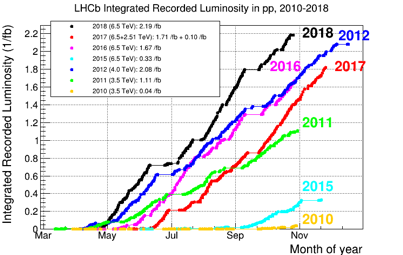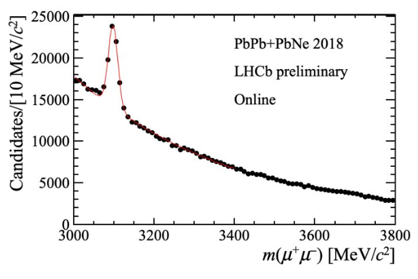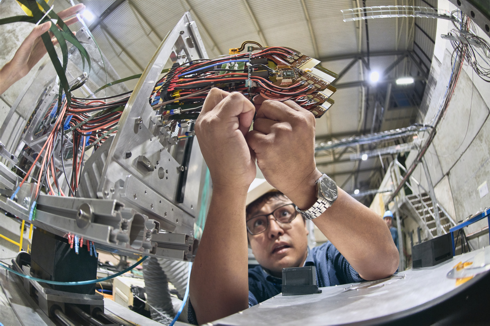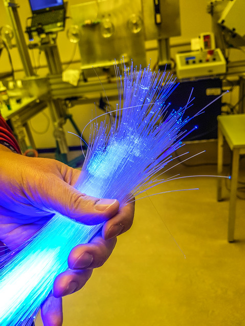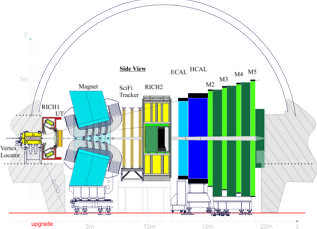End of 2018 data taking period marking the end of Run 2.
At the end of every year, the CERN accelerator complex ends its operation for the usual winter shutdown, in which particle accelerators and experiments perform necessary maintence. But today, when the LHC stopped at 4:38 am, marks the beginning of something very different: the end of the LHC’s Run 2 operation period. After a two-year-long break known as Long Shutdown 2 (LS2), the collider will restart again in 2021 for the Run 3 operation period. For LHCb, today is the end of data taking with detector in its original form. The current experiment will be largely dismantled and an almost completely new detector constructed during the LS2, and a new LHCb will be born in 2021.
The 2018 data taking period was divided into two parts, and was extremely successful. Proton-proton (pp) collisions started on April 28th and were followed by the lead-ion-lead-ion (PbPb) collisions starting on November 9th. The image shows comparison of integrated luminosity recorded by LHCb during different pp data taking periods. This year LHCb recorded 2.19 fb-1, the best performance ever achieved and slightly higher than the value obtained in 2012, the last year of Run 1. The total luminosity collected in Run 2 is nearly 6 fb-1, twice the Run 1 sample of 3 fb-1. Moreover, since the cross-section for b- and b-quark production at 13 TeV proton-proton collisions is about twice that of Run 1 (7 and 8 TeV), the number of beauty particles available for physics analysis is four times higher in the Run 2 data than in Run 1. Excellent perspectives for more and more precise physics results and for the exploration of so-far-inaccessible rare decays are therefore opening for LHCb.
LHCb, the world’s first dedicated b-physics experiment at a hadron collider, is not only producing world-leading results in heavy flavour physics, but it is obtaining important results also in other fields thanks to its excellent detector performances and unique large-rapidity acceptance that make it a general purpose detector in the forward region. LHCb collected the first pPb collision data in 2013 and the first PbPb data in 2015. The 2018 PbPb data taking period was exceptionally successful. The number of collisions per unit time (instantaneous luminosity) was up to 50 times higher than was seen in 2015, thanks to the number of colliding bunches (468) beeing 20 times higher and the focalization of colliding Pb beams beeing twice better, while the overall number of collected events (integrated luminosity) was 20 times higher. The image shows a clearly visible J/ψ peak reconstructed during data taking from the PbPb collisions and from the Pb beam interactions with the injected Ne gas target. LHCb physicists are now eagerly awaiting the offline data processing to start exploring this large PbPb collision data sample.
In pp data taking, bunches of protons can cross every 25 ns at the LHC, corresponding to a frequency of 40 MHz (with about 30 MHz of events with collisions). During Run 1 and 2 the event rate was filtered down to 1 MHz with the help of fast electronics, using comparatively simple algorithms to select the most interesting events. Those events were then processed in a dedicated computer farm, located underground close to the detector; this allowed additional, more sophisticated selection criteria to be applied using software (see the 14 October 2015 news for more). For Run 3 and beyond, this will change radically: the fast electronics will be removed and the whole detector will be read out at the full rate of 40 MHz. This will allow the whole selection to be done in software, meaning that it can be much more precise and flexible. Better yet, from Run 3 the pp collision rate at LHCb will be increased by a factor of 5 (for experts: the luminosity will rise to 2×1033cm-2s-1). With the higher luminosity and a greatly improved ability to pick out the most interesting events, LHCb can look forward to much larger signal yields.
A major fraction of LHCb’s sub-detectors will be replaced or upgraded during LS2 in order to cope with these much more demanding data-taking conditions, using the most recent technological developments to design the new detectors. The VErtex LOcator (VELO) will be replaced by a new silicon pixel detector that will come as close as 5.1 mm to the proton beams (see more). The tracking detectors will be replaced by a new high-granularity silicon micro-strip detector, the Upstream Tracker (UT), placed upstream of the magnet, and by the three stations of the Scintillating Fibre Tracker (SiFi), which is placed downstream the magnet, and consists of 2.5m-long scintillating plastic fibre matrices read out by silicon photo-multipliers. The mirrors of the RICH1 detector will have a larger curvature radius, and the current Hybrid Photon Detectors (HPD) will be replaced by multianode photomultipliers in both RICH1 and RICH2 detectors. The scintillating pad detector (SPD), the preshower (PS) and the first muon chamber (M1) will be removed. The electronics connected directly to the detector (front-end) of all sub-detectors will be modified. And last but not least, the computing power of the LHCb software event selection system (trigger) will be significantly increased as mentioned above, and the entire readout system together with the computer farm will be moved from underground to the surface. The images above show the preparation of a test of the new VELO (left), a bundle of scintillating fibres (right) and the schematic view of the upgrated detector.
Read more in the CERN Press Release in English and French, in the CERN Couriel article and also in the CERN news in English and French.

